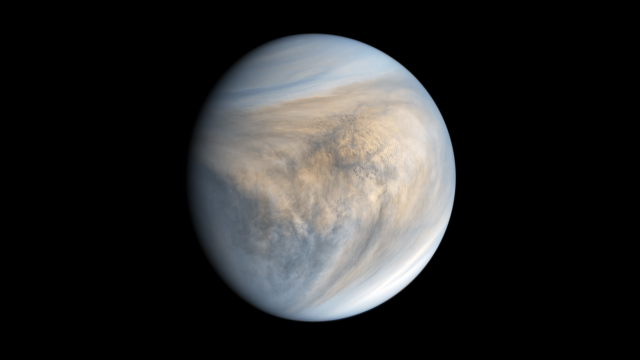While air is a gaseous delight unique to Earth, a team of astrophysicists have made a satisfying discovery: the direct observation of atomic oxygen on Venus’ dayside, confirming that the element crucial for our existence exists on both sides of the hellish planet.
About 96% of the atmosphere on the second planet from the Sun is made up of carbon dioxide, a smidge of other gasses including nitrogen, and practically no oxygen. But there is some oxygen, and some of the element was found previously on Venus’ dark side. Now, the same can be said of the world’s scalding sunny side.
Observations taken across three days in 2021 (including this day two years ago) revealed atomic oxygen at 17 different positions on the planet, including seven on its dayside. The oxygen was spotted about 62 miles (100 kilometres) above its surface, sandwiched between Venus’ sulfuric acid clouds and the strong winds blowing some 75 miles (120 km) above its surface. The team’s research was published in Nature Communications.
The team believes that the oxygen on Venus probably comes from carbon monoxide and carbon dioxide molecules that are broken up by energy from the Sun and are carried to the planet’s dark side by heavy winds in the planet’s upper atmosphere.
“This detection of atomic oxygen on Venus is direct proof for the action of photochemistry—triggered by solar UV radiation—and for the transport of its products by the winds of Venus’ atmosphere,” Helmut Wiesemeyer, an astrophysicist at the Planck Institute for Radio Astronomy and a co-author of the paper, told Reuters.
Venus wasn’t always so uncomfortable, with an average temperature of 850° Fahrenheit and a toxic atmosphere rich with clouds of sulfuric acid. The planet is sometimes referred to as Earth’s fraternal twin, due to the similarities and obvious differences between the two worlds. Venus may have had oceans once, which evaporated when the planet got stuck in a runaway greenhouse effect (though later research indicated what may have been water oceans were actually lakes of lava).
“Venus is not hospitable, at least for organisms we know from Earth,” Heinz-Wilhelm Hübers, a physicist at the German Aerospace Center and lead author of the study, told Reuters. “We are still at the beginning of understanding the evolution of Venus and why it is so different from Earth.”
In quick succession in Spring 2021, NASA and ESA announced three missions focused on Venus; the United States’ space agency had greenlit VERITAS and DAVINCI+, while the Europeans announced the Venus orbiter EnVision. The VERITAS mission has since been delayed due to funding issues, but space agencies remain committed to better understanding the yellowish world, which could offer insights into Earth’s own evolution over its 4.6-odd billion years of existence.
In other words, we’re setting ourselves up for a whole new portrait of the second planet from the Sun, which will come into focus around 2030.
